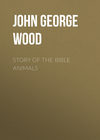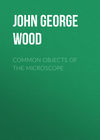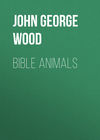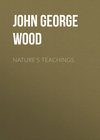Czytaj książkę: «Story of the Bible Animals», strona 32

REPTILES


THE TORTOISE
The Tzab of the Scriptures, translated as Tortoise—Flesh and eggs of the Tortoise—Its slow movements—Hibernation dependent on temperature—The Water-Tortoises—Their food and voracity—Their eggs—Their odour terrifying the horses—The Dhubb lizard and its legends—Its food, and localities which it prefers.
We now come to a different class of animated beings. In Levit. xi. 29, there occurs among the list of unclean beasts a word which is translated in the Authorized Version as "tortoise." The word is Tzab, and is rendered in the Hebrew Bible as "lizard," but with the mark of doubt affixed to it. As the correct translation of the word is very dubious, we shall examine it in both these senses.
The common Tortoise is very common in Palestine, and is so plentiful that it would certainly have been used by the Israelites as food, had it not been prohibited by law. At the present day it is cooked and eaten by the inhabitants of the country who are not Jews, and its eggs are in as great request as those of the fowl.
These eggs are hard, nearly spherical, thick-shelled, and covered with minute punctures, giving them a roughness like that of a file. In captivity the Tortoise is very careless about the mode in which they are deposited, and I have seen a large yard almost covered with eggs laid by Tortoises and abandoned. The white or albumen of the egg is so stiff and gelatinous that to empty one of them without breaking the shell is a difficult task, and the yolk is very dark, and covered with minute spots of black. When fresh the eggs are as good as those of the fowl, and many persons even think them better; the only drawback being that their small size and thick shell cause considerable trouble in eating them.

THE DHUBB OR LIZARD AND THE TORTOISE.
The flesh of the Tortoise is eaten, not only by human beings, but by birds, such as the lämmergeier. In order to get at the flesh of the Tortoise, they carry it high in the air and drop it on the ground so as to break the shell to pieces, should the reptile fall on a stone or rock. If, as is not often the case in such a rocky land as that of Palestine, it should fall on a soft spot, the bird picks it up, soars aloft, and drops it again.
The Tortoises have no teeth, but yet are able to crop the herbage with perfect ease. In lieu of teeth the edges of the jaws are sharp-edged and very hard, so that they cut anything that comes between them like a pair of shears. Leaves that are pulpy and crisp are bitten through at once, but those that are thin, tough, and fibrous are rather torn than bitten, the Tortoise placing its feet upon them, and dragging them to pieces with its jaws. The carnivorous Tortoises have a similar habit, as we shall presently see.

WATER TORTOISE.
This is the species from whose deliberate and slow movements the familiar metaphor of "slow as a Tortoise" was derived, and it is this species which is the hero of the popular fable of the "Hare and the Tortoise." Many of the reptiles are very slow in some things and astonishingly quick in others. Some of the lizards, for example, will at one time remain motionless for many hours together, or creep about with a slow and snail-like progress, while at others they dart from spot to spot with such rapidity that the eye can scarcely follow their movements. This however is not the case with the Tortoise, which is always slow, and, but for the defensive armour in which it is encased, would long ago have been extirpated.
During the whole of the summer months it may be seen crawling deliberately among the herbage, eating in the same deliberate style which characterises all its movements, and occasionally resting in the same spot for many hours together, apparently enjoying the warm beams of the sunshine.
As winter approaches, it slowly scrapes a deep hole in the ground, and buries itself until the following spring awakes it once more to active life. The depth of its burrow depends on the severity of the winter, for, as the cold increases, the Tortoise sinks itself more deeply into the earth.
Mention has been made of a species of Tortoise that inhabits the water. This is the Caspian Emys (Emys caspica), a small species, measuring about six inches in length. It belongs to the large family of the Terrapins, several of which are so well known in America, and has a long, retractile neck, very sharp jaws, and webbed feet, and a well-developed tail.
The body is flattish, and the colour is olive, with lines of yellow edged with black, and the head is marked with longitudinal streaks of bright yellow. After the death of the creature these yellow streaks fade away gradually, and at last become nearly black. The skin of the head is thin, but very hard. In general appearance it is not unlike the chicken Tortoise of America, a species which is often brought to England and kept in captivity, on account of its hardy nature and the little trouble which is needed for keeping it in health.
I have kept specimens of the Caspian Emys for some time, and found them to be more interesting animals than they at first promised to be. They were active, swimming with considerable speed, and snatching quickly at anything which they fancied might be food.
They were exceedingly voracious, consuming daily a quantity of meat apparently disproportioned to their size, and eating it in a manner that strongly reminded me of the mole when engaged on a piece of meat or the body of a bird or mouse. The Tortoise would plant its fore-paws firmly at each side of the meat, seize a mouthful in its jaws, and, by retracting its head violently, would tear away the piece which it had grasped.
They are most destructive among fish, and are apt to rise quietly underneath a fish as it basks near the surface of the water, grasp it beneath with its sharp-edged jaws, and tear away the piece, leaving the fish to die. It is rather remarkable that the Lepidosiren, or mud-fish of the Gambia, destroys fish in a precisely similar manner, though, as its jaws are much sharper than those of the Emys, it does not need the aid of fore-paws in biting out its mouthful of flesh.
Like the land Tortoise, it is one of the hibernators, and during the winter months buries itself deeply in the earth, choosing for this purpose the soft, muddy bed or bank of the pond in which it lives.
Its eggs are white, and hard-shelled, but are more oval than those of the land Tortoise, and both ends are nearly alike. In fact, its egg might well be mistaken for that of a small pigeon. The shell has a porcelain-like look, and is very liable to crack, so that the resemblance is increased.
There is one drawback to these reptiles when kept as pets. They give out a very unpleasant odour, which is disagreeable to human nostrils, but is absolutely terrifying to many animals. The monkey tribe have the strongest objection to these aquatic Tortoises. I once held one of them towards a very tame chimpanzee, much to his discomfiture. He muttered and remonstrated, and retreated as far as he could, pushing out his lips in a funnel-like form, and showing his repugnance to the reptile in a manner that could not be mistaken.
Horses seem to be driven almost frantic with terror, not only by the sight, but by the odour of these Tortoises. In Southern Africa there are Tortoises closely allied to the Caspian Emys, and having the same power of frightening horses.
I have read an account of an adventure there with one of those Tortoises, which I will give. This variety is described as being of an olive colour. When adult, there is a slight depression on either side of the vertebral line.
"Some very awkward accidents have occurred to parties from the terror caused by the fresh-water turtle (Pelamedusa subrufa). Carts have been smashed to fragments, riders thrown, and the utmost confusion caused by them. It is their smell, and it is certainly very disagreeable.
"My first acquaintance with the fact was in this wise. I was out shooting with two young ladies who had volunteered as markers; and, as you know, all our shooting is done from horseback. I had jumped off for a shot at some francolins near a knill, or water-hole, and, after picking up my birds, was coming round the knoll to windward of the horses. In my path scrambled a turtle. I called out to my young friends, and told them of my find, on which one of them, in a hasty voice, said, 'Oh, please, Mr. L., don't touch it; you will frighten the horses!'
"Of course I laughed at the idea, and picked up the reptile, which instantly emitted its pungent odour—its means of defence. Though a long way off, the moment the horses caught the scent, away they flew, showing terror in every action. The girls, luckily splendid riders, tugged in vain at the reins; away they went over the Veldt, leaving me in mortal fear that the yawning 'aard-vark' holes (Orycteropus capensis) would break their necks. My own horse, which I had hitched to a bush, tore away his bridle, and with the ends streaming in the wind and the stirrups clashing about him, sped off home at full gallop, and was only recovered after a severe chase by my gallant young Amazons, who, after a race of some miles, succeeded in checking their affrighted steeds and in securing my runaway. But for some hours after, if I ventured to windward, there were wild-looking eyes and cocked ears—the smell of the reptile clung to me."
Should any of my readers keep any of those water Tortoises, they will do well to supply them plentifully with food, to give them an elevated rocky perch on which they can scramble, and on which they will sit for hours so motionless that at a little distance they can scarcely be distinguished from the stone on which they rest. They should also be weighed at regular intervals, as decrease of weight is a sure sign that something is wrong, and, as a general rule, is an almost certain precursor of death.
This little reptile is not without its legends. According to the old writers on natural history, it is of exceeding use to vine-growers in the season when there is excess of rain or hail. Whenever the owner of a vineyard sees a black cloud approaching, all he has to do is, to take one of these Tortoises, lay it on its back, and carry it round the vineyard. He must then go into the middle of the ground and lay the reptile on the earth, still on its back; and the effect of this proceeding would be that the cloud would pass aside from a place so well protected.
"But," proceeds the narrator, not wishing to be responsible for the statement, "such diabolical and foolish observations were not so muche to be remembered in this place, were it not for their sillinesse, that by knowing them men might learn the weaknesse of human wisdom when it erreth from the fountain of all science and true knowledge (which is Divinity), and the most approved assertions of nature. And so I will say no more in this place of the sweet-water tortoise."
THE DHUBB
We now come to the second animal, which may probably be the Tzab of the Old Testament.
This creature is one of the lizards, and is a very odd-looking creature. It is certainly not so attractive in appearance that the Jews might be supposed to desire it as food; but it often happens that, as is the case with the turtle and iguana, from the most ungainly, in the latter animal even repulsive, forms are produced the most delicate meats.
The Dhubb, or Egyptian Mastigure, as the lizard is indifferently called, grows to a considerable size, measuring when adult three feet in length. Its colour is green, variegated with brown, and is slightly changeable, though not to the extent that distinguishes the chameleon. The chief peculiarity of this lizard consists in its tail, which is covered with a series of whorls or circles of long, sharply-pointed, hard-edged scales. The very appearance of this tail suggests its use as a weapon of defence, and it is said that even the dreaded cerastes is conquered by it, when the lizard and the snake happen to find themselves occupants of the same hole.
The ancients had a very amusing notion respecting the use of the spiny tail possessed by the Dhubb and its kin. They had an idea that, comparatively small though it was, it fed upon cattle, and that it was able to take them from the herd and drive them to its home. For this purpose, when it had selected an ox, it jumped on its back, and by the pricking of its sharp claws drove the animal to gallop in hope of ridding himself of his tormentor. In order to guide him in the direction of its home, it made use of its tail, lashing the ox "to make him go with his rider to the place of his most fit execution, free from all rescue of his herdsman, or pastor, or the annoyance of passengers, where, in most cruel and savage manner, he teareth the limbs and parts one from another till he be devoured."
This very absurd account is headed by an illustration, which, though bad in drawing and rude in execution, is yet so bold and truthful that there is no doubt that it was sketched from the living animal.
As it haunts sandy downs, rocky spots, and similar localities, it is well adapted for the Holy Land, which is the home of a vast number of reptiles, especially of those belonging to the lizards. In the summer time they have the full enjoyment of the hot sunbeams, in which they delight, and which seem to rouse these cold-blooded creatures to action, while they deprive the higher animals of all spirit and energy. In the winter time these very spots afford localities wherein the lizards can hibernate until the following spring, and in such a case they furnish the reptiles with secure hiding-places.
Although the Dhubb does not destroy and tear to pieces oxen and other cattle, it is yet a rather bloodthirsty reptile, and will kill and devour birds as large as the domestic fowl. Usually, however, its food consists of beetles and other insects, which it takes deliberately.

THE LEVIATHAN OR CROCODILE
Signification of the word Leviathan—Description in the Book of Job—Structure and general habits of the Crocodile—The throat-valve and its use—Position of the nostrils—Worship of the Crocodile—The reptile known in the Holy Land—Two legends respecting its presence there—Mode of taking prey—Cunning of the Crocodile—The baboons and the Crocodile—Speed of the reptile—Eggs and young of the Crocodile, and their enemies—Curious story of the ichneumon and ibis—Modes of capturing the Crocodile—Analysis of Job's description—The Crocodile also signified by the word Tannin. Aaron's rod changed into a Tannin—Various passages in which the word occurs—Use of the word by the prophet Jeremiah.
The word Leviathan is used in a rather loose manner in the Old Testament, in some places representing a mammalian of the sea, and in others signifying a reptile inhabiting the rivers. As in the most important of these passages the Crocodile is evidently signified, we will accept that rendering, and consider the Crocodile as being the Leviathan of Scripture. The Jewish Bible accepts the word Crocodile, and does not add the mark of doubt.
The fullest account of the Leviathan occurs in Job xli., the whole of which chapter is given to the description of the terrible reptile. As the translation of the Jewish Bible differs in some points from that of the Authorized Version, I shall here give the former, so that the reader may be able to compare them with each other.
"Canst thou draw out a crocodile with a hook, or his tongue with a cord which thou lettest down?
"Canst thou put a reed into his nose, or bore his jaw through with a thorn?
"Will he make many supplications unto thee? will he speak soft words unto thee?
"Will he make a covenant with thee? wilt thou take him as a servant for ever?
"Wilt thou play with him as with a bird, or wilt thou bind him for thy maidens?
"Shall the companions make a banquet of him? shall they part him among the merchants?
"Canst thou fill his skin with barbed irons, or his head with fish-spears?
"Lay thine hand upon him, thou wilt no more remember the battle.
"Behold, the hope of him is in vain; shall not one be cast down at the sight of him?
"None is so fierce that dare stir him up; who then is able to stand before Me?
"Who hath forestalled Me that I should repay him? whatsoever is under the whole heaven is Mine.
"I will not be silent of his parts, nor of the matter of his power, nor of his comely proportion.
"Who can uncover the face of his garment? who would enter the double row in his jaw?
"Who can open the doors of his face? his teeth are terrible round about.
"The strength of his shields are his pride, shut up together as with a close seal.
"One is so near to another that no air can come between them.
"They are joined one to another, they stick together that they cannot be sundered.
"His snortings make light to shine, and his eyes are like the eyelids of the morning dawn.
"Out of his nostrils goeth smoke, as out of a seething pot or caldron.
"His breath kindleth live coals, and a flame goeth out of his mouth.
"In his neck abideth strength, and before him danceth terror.
"The flakes of his flesh are joined together, they are firm in themselves; yea, as hard as nether millstone.
"When he raiseth himself up, the mighty are afraid; by reason of breakings they lose themselves.
"The sword of him that layeth at him cannot hold: the spear, the dart, nor the habergeon.
"He esteemeth iron as straw, and copper as rotten wood.
"The arrow cannot make him flee: sling-stones are turned with him into stubble.
"Clubs are counted as stubble; he laugheth at the shaking of a spear.

CROCODILE ATTACKING HORSES.
"His under parts are like sharp points of potsherd; he speaketh sharp points upon the mire.
"He maketh the deep to boil like a pot; he maketh the sea like a pot of ointment.
"He maketh a path to shine after him; one would think the deep to be hoary.
"Upon earth there is not his like, who is made without fear.
"He beholdeth all high things; he is a king over all the children of pride."
This splendid description points as clearly to the Crocodile as the description of the Behemoth which immediately precedes it does to the hippopotamus, and it is tolerably evident that the sacred poet who wrote these passages must have been personally acquainted with both the Crocodile and the hippopotamus. In both descriptions there are a few exaggerations, or rather, poetical licences. For example, the bones of the hippopotamus are said to be iron and copper, and the Crocodile is said to kindle live coals with his breath. These, however, are but the natural imagery of an Oriental poet, and, considering the subject, we may rather wonder that the writer has not introduced even more fanciful metaphors.
Description of the Crocodile.
There are several species of Crocodile in different parts of the world, ten species at least being known to science.
Some inhabit India, some tropical America, some Asia, and some Africa, so that the genus is represented in nearly all the warmer parts of the world.
They are all known by the formation of the teeth, the lower canines fitting each into a notch on the side of the upper jaw. The feet are webbed to the tips, and though the reptile mostly propels itself through the water by means of its tail, it can also paddle itself gently along by means of its feet.
The teeth are all made for snatching and tearing, but not for masticating, the Crocodile swallowing its prey entire when possible; and when the animal is too large to be eaten entire, the reptile tears it to pieces, and swallows the fragments without attempting to masticate them.
In order to enable it to open its mouth under water, the back of its throat is furnished with a very simple but beautiful contrivance, whereby the water is received on a membranous valve and, in proportion to its pressure, closes the orifice of the throat. As the Crocodiles mostly seize their prey in their open jaws and hold it under water until drowned, it is evident that without such a structure as has been described the Crocodile would be as likely to drown itself as its prey. But the throat-valve enables it to keep its mouth open while the water is effectually prevented from running down its throat, and the nostrils, placed at the end of the snout, enable it to breathe at its ease, while the unfortunate animal which it has captured is being drowned beneath the surface of the water.
This position of the nostrils serves another purpose, and enables the Crocodile to breathe while the whole of its body is under the water, and only an inch or two of the very end of the snout is above the surface. As, moreover, the Crocodile, as is the case with most reptiles, is able to exist for a considerable time without breathing, it only needs to protrude its nostrils for a few moments, and can then sink entirely beneath the water. In this way the reptile is able to conceal itself in case it should suspect danger; and as, in such instances, it dives under the herbage of the river, and merely thrusts its nose into the air among the reeds and rushes, it is evident that, in spite of its enormous size, it baffles the observation of almost every foe.
Among reptiles, the mailed Crocodiles may be mentioned as most formidable foes to man. Vast in bulk, yet grovelling with the belly on the earth; clad in bony plates with sharp ridges; green eyes with a peculiar fiery stare, gleaming out from below projecting orbits; lips altogether wanting, displaying the long rows of interlocking teeth even when the mouth is closed, so that, even when quiet, the monster seems to be grinning with rage,—it is no wonder that the Crocodile should be, in all the countries which it inhabits, viewed with dread.
Nor is this terror groundless. The Crocodiles, both of the Nile and of the Indian rivers, are well known to make man their victim, and scarcely can a more terrible fate be imagined than that of falling into the jaws of this gigantic reptile. Strange as it may appear, the Crocodile is one of the many animals to which divine honours were paid by the ancient Egyptians. This we learn from several sources. Herodotus, for example, in "Euterpe," chapter 69, writes as follows: "Those who dwell about Thebes and Lake Mœris, consider them to be very sacred; and they each of them train up a Crocodile, which is taught to be quite tame; and they put crystal and gold ear-rings into their ears, and bracelets on their fore-paws; and they give them appointed and sacred food, and treat them as well as possible while alive and when dead, they embalm them, and bury them in sacred vaults."

A CROCODILE POOL OF ANCIENT EGYPT.
The reasons for this worship are several. At the root of them all lies the tendency of man to respect that which he fears rather than that which he loves; and the nearer the man approaches the savage state, the more is this feeling developed. By this tendency his worship is regulated, and it will be found that when man is sufficiently advanced to be capable of worship at all, his reverence is invariably paid to the object which has the greatest terrors for him. The Crocodile, therefore, being the animal that was most dreaded by the ancient Egyptians, was accepted as the natural type of divinity.

CROCODILES OF THE UPPER NILE.
Owing to the accuracy of the description in the Book of Job, which is evidently written by one who was personally acquainted with the Crocodile, it is thought by many commentators that the writer must have been acquainted with the Nile, in which river both the Crocodile and hippopotamus are found at the present day.
It is possible, however, that the hippopotamus and the Crocodile have had at one time a much wider range than they at present enjoy. Even within the memory of man the hippopotamus has been driven further and further up the Nile by the encroachments of man. It has long been said that even at the present day the Crocodile exists in Palestine in the river which is called "Nhar Zurka," which flows from Samaria through the plains of Sharon. Several of the older writers have mentioned its existence in this river, and, since this work was commenced, the long-vexed question has been set at rest; a Crocodile, eight feet in length, having been captured in the Nhar Zurka.
No description of the Crocodile would be complete without allusion to the mode in which it seizes its prey. It does not attack it openly, neither, as some have said, does it go on shore for that purpose. It watches to see whether any animal comes to drink, and then, sinking beneath the surface of the water, dives rapidly, rises unexpectedly beneath the unsuspecting victim, seizes it with a sudden snap of its huge jaws, and drags it beneath the water. Should the intended prey be too far from the water to be reached by the mouth, or so large that it may offer a successful resistance, the Crocodile strikes it a tremendous blow with its tail, and knocks it into the water. The dwellers on the Nile bank say that a large Crocodile will with a single blow of its tail break all the four legs of an ox or a horse.
These cunning reptiles even contrive to catch birds as they come for water. On the banks of the Nile the smaller birds drink in a very peculiar manner. They settle in numbers on the flexible branches that overhang the stream, and when, by their weight, the branch bends downwards, they dip their beaks in the water. The Crocodile sees afar off a branch thus loaded, swims as near as possible, and then dives until it can see the birds immediately above it, when it rises suddenly, and with a snap of its jaws secures a whole mouthful of the unsuspecting birds.
Sir S. Baker, in his travels on the Nile, gave much attention to the Crocodile, and has collected a great amount of interesting information about the reptile, much of which is peculiarly valuable, inasmuch as it illustrates the Scriptural notices of the creature. He states that it is a very crafty animal, and that its usual mode of attack is by first showing itself, then swimming slowly away to a considerable distance, so as to make its intended victim think that danger is over, and then returning under water. It is by means of this manœuvre that it captures the little birds. It first makes a dash at them, open-mouthed, causing them to take to flight in terror. It then sails slowly away as if it were so baffled that it did not intend to renew the attack. When it is at a considerable distance, the birds think that their enemy has departed, and return to the branch, which they crowd more than ever, and in a minute or two several dozen of them are engulfed in the mouth of the Crocodile, which has swiftly dived under them.
On one occasion, Sir S. Baker was walking near the edge of the river, when he heard a great shrieking of women on the opposite bank. It turned out that a number of women had been filling their "gerbas" (water-skins), when one of them was suddenly attacked by a large Crocodile. She sprang back, and the reptile, mistaking the filled gerba for a woman, seized it, and gave the owner time to escape. It then dashed at the rest of the women, but only succeeded in seizing another gerba.
A short time previously a Crocodile, thought by the natives to be the same individual, had seized a woman and carried her off; and another had made an attack on a man in a very curious manner. A number of men were swimming across the river, supported, after their custom, on gerbas inflated with air, when one of them felt himself seized by the leg by a Crocodile, which tried to drag him under water. He, however, retained his hold on the skin, and his companions also grasped his arms and hair with one hand, while with the other they struck with their spears at the Crocodile. At last they succeeded in driving the reptile away, and got their unfortunate companion to land, where they found that the whole of the flesh was stripped from the leg from the knee downwards. The poor man died shortly afterwards.
Another traveller relates that three young men who were obliged to cross a branch of a river in their route, being unable to procure a boat, endeavoured to swim their horses to the opposite shore. Two of them had reached the bank in safety, but the third loitered so long on the brink as only to have just entered the water at the moment his comrades had reached the opposite side. When he was nearly half-way across, they saw a large Crocodile, which was known to infest this pass, issuing from under the reeds. They instantly warned their companion of his danger; but it was too late for him to turn back. When the Crocodile was so close as to be on the point of seizing him, he threw his saddle-bag to it. The ravenous animal immediately caught the whole bundle in its jaws, and disappeared for a few moments, but soon discovered its mistake, and rose in front of the horse, which, then seeing it for the first time, reared and threw its rider. He was an excellent swimmer, and had nearly escaped by diving towards the bank; but, on rising for breath, his pursuer also rose, and seized him by the middle. This dreadful scene, which passed before the eyes of his companions, without the least possibility of their rendering any assistance, was terminated by the Crocodile, having previously drowned the unfortunate man, appearing on an opposite sand-bank with the body, and there devouring it.
The crafty Crocodile tries to catch the baboons by lying in wait for them at their drinking places; but the baboons are generally more than a match for the Crocodile in point of cunning and quickness of sight. Sir S. Baker witnessed an amusing example of such an attempt and its failure.
"The large tamarind-trees on the opposite bank are generally full of the dog-faced baboons (Cynocephalus) at their drinking hour. I watched a large Crocodile creep slily out of the water and lie in waiting among the rocks at the usual drinking place before they arrived, but the baboons were too wide awake to be taken in so easily.
"A young fellow was the first to discover the enemy. He had accompanied several wise and experienced old hands to the extremity of a bough that at a considerable height overhung the river; from this post they had a bird's eye view, and reconnoitred before one of the numerous party descended to drink. The sharp eyes of the young one at once detected the Crocodile, who matched in colour so well with the rocks that most probably a man would not have noticed it until too late.















